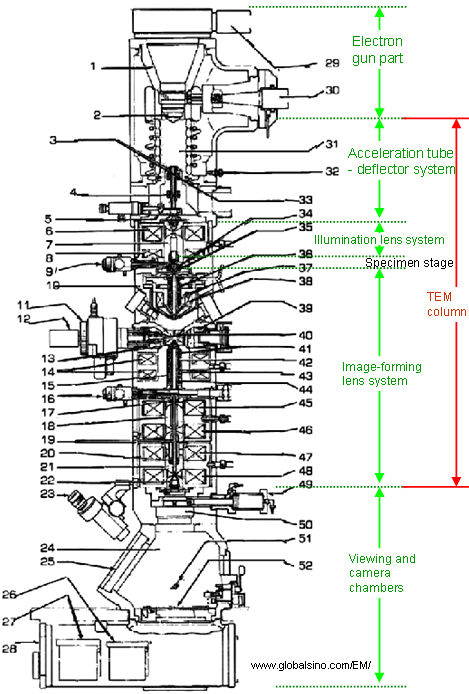|
|
Illumination in STEM Mode
- Practical Electron Microscopy and Database -
- An Online Book -
|
|
https://www.globalsino.com/EM/
|
|
This book (Practical Electron Microscopy and Database) is a reference for TEM and SEM students, operators, engineers, technicians, managers, and researchers.
|
=================================================================================
The schematic illustration in Figure 4943 presents the position of illumination part in typical (S)TEM systems.
 |
1. Electron gun
2. Wehnelt unit
3. Anode
4. Electron gun second beam delector coil
5. Anode chamber isolation valve
6. 1st condenser lens coil
7. Condenser polepiece
8. 3rd condenser lens coil
9. Condenser aperture assembly
10. Specimen chamber
11. Goniometer
12. specimen holder
13. Stigmator screening cylinder
14. Objective lens coil
15. Objective lens liner tube
16. Field limiting aperture
17. Intermediate lens stigmator
18. Intermediate polepiece
19. Intermediate lens linear tube
20. Projector lens beam deflector coil
21. Projector upper polepiece
22. Projector lower polepiece
23. Binoculars
24. Viewing chamber
25. Viewing window
26. Dispensing magazine
27. Receiving magazine
28. Camera chamber
29. Lift arm
30. HT cable to high voltage tank
31. Anode chamber, or called acceleration tube
32. Gas inlet
33. Electron gun 1st beam deflector coil
34. Condenser lens stigmator coil
35. Spot alignment coil
36. Condenser lens 1st beam deflector coil
37. Condenser lens 2nd beam deflector coil
38. Condenser minilens (CM) lens coil
39. Stage heater
40. Objective polepiece
41. Objective lens stigmator coil
42. 1st image shift coil
43. Objective minilens (OM) lens coil
44. 2nd image shift coil
45. 1st intermediate lens coil
46. 2nd intermediate lens coil
47. 3rd intermediate lens coil
48. Projector lens coil
49. Viewing chamber isolation valve
50. High resolution diffraction chamber
51. Small screen
52. Large screen |
Figure 4943. Schematic illustration of the structure of typical TEM systems (e.g. JEM-2010F
here). |
In contrast to conventional TEM (CTEM) system, modern field emission gun TEM (FEG-TEM) systems are often equipped with scanning coils that allow
the microscopes to be used in scanning mode. In this mode, the electron beam is focused on the specimen by the condenser lenses and the
objective prefield lens. The small probe therefore is scanned across the area of interest in the specimen plane. The image is obtained either (a) from electrons that have not been
scattered or are only under small angles to form a bright-field image or (b) from electrons that have undergone
large-angle scattering events to form an annular-dark-field (ADF) image. If the detected electrons are from scattering at
angles between ~ 50 – 100 mrad, the ADF mode is called high-angle annular dark-
field (HAADF) mode. Microscopes operating only in the scanning mode are
called scanning TEMs (STEMs). More readings can be obtained at Difference of Imaging Geometries of TEM and STEM Systems.
We need to recalibrate the condenser lens adjustment from the FilterControl software if the EEL specimen illumination changes when the spectrum offset is changed.
|
=================================================================================
The book author (Yougui Liao) welcomes your comments, suggestions, and corrections, please click here for submission. If you let book author know once you have cited this book, the brief information of your publication will appear on the “Times Cited” page.
|
|
